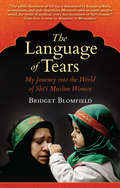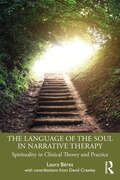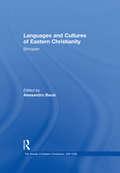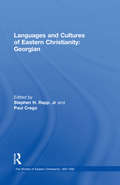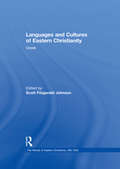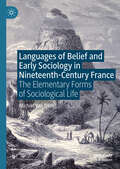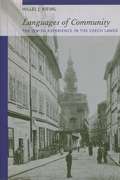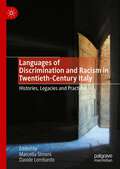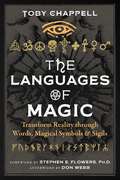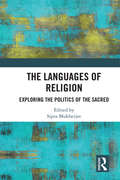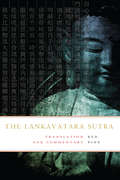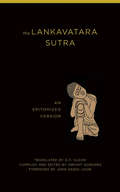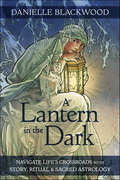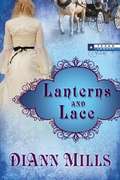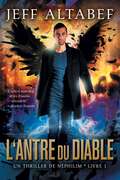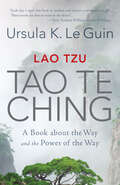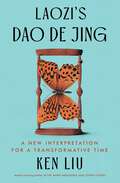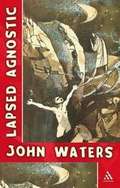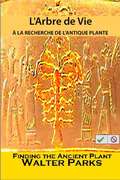- Table View
- List View
The Language of Tears
by Bridget BlomfieldThe Language of Tears details the engaging five-year experience of a gifted American scholar throughout her journey teaching and participating in a Shi'a Muslim community in Southern California. As a teacher in a Muslim school, she participates in the lives of Iranian, Iraqi, and Pakistani women as they perform their religious rituals. Initially thought to be an FBI informant, Blomfield builds trust as she participates in every aspect of their lives.Only a few weeks after she starts teaching, the fifth-grade girls invite her to attend a religious ritual after school. Sitting, covered in black, she starts to engage: hearing the laments of the women, she too starts to weep. She is invited into the women's homes, where they share their hopes, dreams, and fears. She dances at weddings, baby showers, and a Mother's Day "women's only" swim party. She is deeply honored when she is invited to ritually wash and bury an old Iranian woman's body, erupting a love for her own mother and her imminent death. Finally, she travels to Iran for a surreal religious pilgrimage where she becomes Shi'a "in her heart," becoming more fully human.
Language of the Heart: A Sufi Interpretation of Form (Sura) and Meaning (Mana) in Contemporary Society
by Eva Desiree van den BergThis book seeks to examine how Sufi thought might provide critical understanding of contemporary life and a pathway towards the recovery of a more meaningful existence. Rumi&’s mystical teachings are of great value at a time of rampant materialism and indiscriminate consumerism, and have the potential to illuminate the precarious state of the world, as well as revitalize contemporary social critique, eco-philosophy and bio-semiotics in what is increasingly being regarded as a post-secular age.
The Language of the Soul in Narrative Therapy: Spirituality in Clinical Theory and Practice
by Laura BéresThe Language of the Soul in Narrative Therapy uniquely bridges the gap between narrative therapy and spirituality to describe how the theory and practice of narrative therapy may be expanded and enriched by incorporating the language of the soul. Divided into three parts, the book begins by contextualizing the approach of narrative therapy and spirituality. Chapters then debate the complexity of the ‘soul’ as a term drawing on the work of Christian mystics and philosophers, such as Teresa of Avila, Edith Stein, Merleau-Ponty, and Bakhtin, to show how their theoretical ideas can be incorporated in counseling practice and spiritual direction. The book concludes by discussing how the language of the soul can be integrated and applied in postmodern practice. With case examples from faith belief systems, such as Christianity, Buddhism, Paganism, Wicca, and Yazidism, throughout, this book is essential reading for therapists, clinical social workers, and counsellors in practice and graduate training, as well as spiritual directors and pastoral counselors interested in the ideas and practices of narrative therapy.
The Language of Trauma in the Psalms (Critical Studies in the Hebrew Bible)
by Danilo VerdeOver the last few decades, the field of trauma studies has shed new light on biblical texts that deal with individual and collective catastrophe. In The Language of Trauma in the Psalms, Danilo Verde advances the conversation, moving beyond the emphasis on healing that prevails in most literary trauma studies. Using the lens of cognitive linguistics and combining insights from trauma studies and redaction criticism, Verde explores how trauma is expressed linguistically in the book of Psalms, how trauma-related language was rooted in ancient Israel’s external realities, and how psalms helped define Yehud’s cultural trauma in the Persian period (539–331 BCE). Rather than assuming the psalmists’ personal experiences are reflected in these texts, Verde focuses on the linguistic strategies used to express trauma in the Psalms, especially references to the body and highly dramatic metaphors. Current analyses often approach trauma texts as tools intended to help sufferers heal. Verde contends that many group laments in the book of Psalms were transmitted not only to heal but also to wound the community, ensuring that the pain of a previous generation was not forgotten.The Language of Trauma in the Psalms shifts our understanding of trauma in biblical texts and will appeal to literary trauma scholars as well as those interested in ancient Israel.
Languages and Cultures of Eastern Christianity: Ethiopian (The Worlds of Eastern Christianity, 300-1500 #4)
by Alessandro BausiThis volume brings together a set of contributions, many appearing in English for the first time, together with a new introduction, covering the history of the Ethiopian Christian civilization in its formative period (300-1500 AD). Rooted in the late antique kingdom of Aksum (present day Northern Ethiopia and Eritrea), and lying between Byzantium, Africa and the Near East, this civilization is presented in a series of case studies. At a time when philological and linguistic investigations are being challenged by new approaches in Ethiopian studies, this volume emphasizes the necessity of basic research, while avoiding the reduction of cultural questions to matters of fact and detail.
Languages and Cultures of Eastern Christianity: Georgian (The Worlds of Eastern Christianity, 300-1500 #5)
by Stephen H. Rapp Paul CregoThis volume brings together a set of key studies on the history and culture of Christian Georgia, along with a substantial new introduction. The opening section sets the regional context, in relation to the Byzantine empire in particular, while subsequent parts deal with the conversion and christianization of the country, the making of a 'national' church and the development of a historical identity.
Languages and Cultures of Eastern Christianity: Greek (The Worlds of Eastern Christianity, 300-1500)
by Scott Fitzgerald JohnsonThis volume brings together a set of fundamental contributions, many translated into English for this publication, along with an important introduction. Together these explore the role of Greek among Christian communities in the late antique and Byzantine East (late Roman Oriens), specifically in the areas outside of the immediate sway of Constantinople and imperial Asia Minor. The local identities based around indigenous eastern Christian languages (Syriac, Coptic, Armenian, Georgian, etc.) and post-Chalcedonian doctrinal confessions (Miaphysite, Church of the East, Melkite, Maronite) were solidifying precisely as the Byzantine polity in the East was extinguished by the Arab conquests of the seventh century. In this multilayered cultural environment, Greek was a common social touchstone for all of these Christian communities, not only because of the shared Greek heritage of the early Church, but also because of the continued value of Greek theological, hagiographical, and liturgical writings. However, these interactions were dynamic and living, so that the Greek of the medieval Near East was itself transformed by such engagement with eastern Christian literature, appropriating new ideas and new texts into the Byzantine repertoire in the process.
Languages of Belief and Early Sociology in Nineteenth-Century France: The Elementary Forms of Sociological Life
by Michiel Van DamThis book presents a new reading of the history of French social science and religion through an investigation of early sociology’s techniques for narrating the category of belief. The author argues that by looking at the history of social sciences in this manner, we gain a deeper understanding of both our present debates on post-secularity as well as our modernist past, both of which were thoroughly shaped by their reflections and critiques on the notion of belief yet failed to enter into any sort of meaningful communication with each other. This book seeks to rectify this failure by introducing the concept of ‘belief-languages’, an anthropological framework designed to historicize different discussions on belief and allow for their comparative description and analysis.
Languages of Community: The Jewish Experience in the Czech Lands
by Hillel J. KievalIn the Czech lands, Kieval writes, Jews have felt the need constantly to define and articulate the nature of group identity, cultural loyalty, memory, and social cohesiveness, and the period of "modernizing" absolutism, which began in 1780, brought changes of enormous significance.
Languages of Discrimination and Racism in Twentieth-Century Italy: Histories, Legacies and Practices
by Marcella Simoni Davide LombardoThis volume represents one of the first extensive studies that investigates the persistence of questions of race and racism in Italy from the liberal age to the present, through colonialism, Fascism and post-war Italy. It adopts an interdisciplinary perspective to investigate the intertwining of the cultural, social, legislative and political dynamics of discrimination in Italy’s past and present. Drawing upon the expertise of historians, political scientists, sociologists, scholars of literature and experts in cultural studies, the original essays collected in this volume show a remarkable continuity and the persistence of racism in the Italian cultural and political discourse, in society and in the representation of Others. They also speak of the shifting of practices of Othering from one group to another in different historical contexts.
The Languages of Magic: Transform Reality through Words, Magical Symbols, and Sigils
by Toby Chappell• Introduces key ideas in linguistics and semiotics to reveal how magic works• Reveals how to apply effective communication techniques to your magical practice• Includes case studies of magical schools, such as Hermetic magic, sigil magic, Thelema, the Church of Satan, Chaos Magic, and the Temple of SetIn this illuminating and deeply informative guide, practicing magician Toby Chappell takes readers on a journey into the heart of what it means to transform reality by exploring what magic is. He explains that operative magic works because it is communication. The practitioner of magic is communicating with the unmanifest to align the outside world with their inner transformations, desires, and needs.Drawing on linguistics and the analytical techniques of semiotics, the author explores how we perceive and affect the world by treating it like a partner in communication. He shows how this notion of magical communication appears in ancient practice, looking specifically at Hermetic magic and the spells of Greek magical papyri, sigil magic, Enochian magic, and runes. He explains the symbol-building necessary to effectively transform your inner and outer reality with magical speech, signs, and sigils. The author examines the languages of magic in contemporary New Thought practices, and he also looks at magical communication in several modern and postmodern schools of magic, including Thelema and the teachings of Aleister Crowley, Thee Temple ov Psychick Youth, the Church of Satan, Chaos Magic, and the Temple of Set.Revealing how to apply techniques of effective communication to the magical realm, the author shows how you can deepen your understanding of magical practice and, ultimately, perform magic with greater success.
The Languages of Religion: Exploring the Politics of the Sacred
by Sipra MukherjeeThis book analyses the power that religion wields upon the minds of individuals and communities and explores the predominance of language in the actual practice of religion. Through an investigation of the diverse forms of religious language available — oral traditions, sacred texts, evangelical prose, and national rhetoric used by ‘faith-insiders’ such as missionaries, priests, or religious leaders who play the communicator’s role between the sacred and the secular — the chapters in the volume reveal the dependence of religion upon language, demonstrating how religion draws strength from a past that is embedded in narratives, infusing the ‘sacred’ language with political power. The book combines broad theoretical and normative reflections in contexts of original, detailed and closely examined empirical case studies. Drawing upon resources across disciplines, the book will be of interest to scholars of religion and religious studies, linguistics, politics, cultural studies, history, sociology, and social anthropology.
The Lankavatara Sutra: Translation and Commentary
by Red PineHaving translated The Diamond Sutra and The Heart Sutra, and following with The Platform Sutra, Red Pine now turns his attention to perhaps the greatest Sutra of all. The Lankavatara Sutra is the holy grail of Zen. Zen's First Patriarch, Bodhidharma, gave a copy of this text to his successor, Hui-k'o, and told him everything he needed to know was in this book. Passed down from teacher to student ever since, this is the only Zen sutra ever spoken by the Buddha. Although it covers all the major teachings of Mahayana Buddhism, it contains but two teachings: that everything we perceive as being real is nothing but the perceptions of our own mind and that the knowledge of this is something that must be realized and experienced for oneself and cannot be expressed in words. In the words of Chinese Zen masters, these two teachings became known as "have a cup of tea" and "taste the tea." This is the first translation into English of the original text used by Bodhidharma, which was the Chinese translation made by Gunabhadra in 443 and upon which all Chinese Zen masters have relied ever since.In addition to presenting one of the most difficult of all Buddhist texts in clear English, Red Pine has also added summaries, explanations and notes, including relevant Sanskrit terms on the basis of which the Chinese translation was made. This promises to become an essential text for anyone seeking to deepen their understanding or knowledge of Zen.
The Lankavatara Sutra
by D. T. Suzuki Dwight GoddardSaid to contain the words of the Buddha on the nature of ultimate wisdom, the Lankavatara was influential in the general doctrines of Mahayana Buddhism, in particular Zen. Translated by D.T Suzuki and edited by Dwight Goddard, this epitomized version was intended to make the sutra more widely accessible.
A Lantern in The Dark: Navigate Life's Crossroads with Story, Ritual & Sacred Astrology
by Danielle BlackwoodMeditations, Stories & Rituals for Life's CrossroadsAll too often, when we find ourselves at a crossroads, the conventional ways of understanding where we are can fall short of the mark. Intuitively, we know we need something more. Sacred astrology teaches that there are several distinct rites of passage that can show up as a psychospiritual crisis characterized by intense challenge and confusion. We are betwixt and between—no longer who we used to be, but not yet who we are becoming. However, these powerful thresholds are where the real magic of our lives happens. They usually coincide with significant turning points that lead us toward our life's unique purpose.Learn how myth, folklore and story can be a source of guidance in difficult times. Illuminate the archetypal dimensions of your own story and re-enchant your life. Learn when to expect the crossroad times throughout your life so you can make peace with the past, navigate the present, and create a more purposeful future. Discover the keys to self realization and step into alignment with who you’re becoming. Create a self-care tool kit for the distinct issues that arise with each crossroads, and get clear about what you're calling in. Unlock new levels of self awareness through ritual, guided meditation, and journal reflections crafted specifically for each threshold. You will also learn how to support family, friends, coworkers, and clients who are going through difficult times with a transpersonal understanding of where they are and what they're going through.Having insight into what time it is in your life can be a lantern in the dark.
Lanterns and Lace (Texas Legacy #2)
by Diann MillsBest-selling author, DiAnn Mills, has created a compelling, historical romance set in Texas during the late 1800s. In this second book of the Texas Legacy series, heroine Jenny Martin believes the one thing that will guarantee her happiness is to remove her deceased sister's daughter from the home of Dr. Grant Andrews. But she is caught off-guard when she discovers the doctor is single and attractive. Then when danger stalks Jenny and those around her, she wonders if she is doing more harm than good by staying in Kahlerville.
L'antre du Diable: Un thriller surnaturel captivant (Un thriller de Néphilim #1)
by Jeff AltabefMon nom est Steven Cabbott, et je suis un ancien espion avec un passé sombre. J'essaie de changer, mais certaines habitudes vous collent à la peau, et tuer est l'une de ces habitudes. •GAGNANT : Pinnacle Book Achievement Award - Meilleur thriller (été 2018) •GAGNANT : Readers' Favorite Book Award - Médaille de bronze : Fiction - Surnaturel (2019) •FINALISTE : Next Generation Indie Book Award - Paranormal (2019) J'ai récemment commencé à voir des démons et j'ai même dû en combattre quelques-uns. Je soupçonne que cela a quelque chose à voir avec ma mère qui est folle à lier. Elle a tué mon père quand j'étais jeune, prétendant qu'il était un démon. Je pensais qu'elle était folle. Maintenant, je n'en suis plus si sûr. Je suis rentré chez moi pour découvrir la vérité sur mon passé, quand mon ancien amour, Kate, m'a demandé de l'aide. Je n'avais pas eu de ses nouvelles depuis seize ans, mais je lui dois bien ça. Une secte mystérieuse a kidnappé sa fille adolescente, et je suis la seule chance qu'elle a de la récupérer. Ce qui semble être une simple affaire se transforme en un combat bien plus important entre la lumière et les ténèbres. Il semble que le paradis et l'enfer veuillent utiliser mes services, ce qui m'oblige à faire un choix plutôt difficile. Pour ne rien arranger, un ange déchu veut une relation romantique malsaine avec moi et n'accepte pas de refus. Du moins, c'est ce que je pense, mais pour être honnête, je n'ai qu'une vague prise sur la réalité pour le moment. Si vous aimez Jim Butcher, Michael Anderle, Shayne Silvers ou K.F. Breene, vous adorerez la série « Un thriller de Néphilim», acclamée par la critique. EVOLVED PUBLISHING PRÉSENTE un regard intriguant et passionnant sur une grande bataille entre le bien et le mal, qui pourrait mener à la fin des temps, avec le premier
Lao Tzu: Tao Te Ching
by Ursula K. Le GuinNo other English translation of this greatest of the Chinese classics can match Ursula Le Guin's striking new version. Le Guin, best known for thought-provoking science fiction novels that have helped to transform the genre, has studied the Tao Te Ching for more than forty years. She has consulted the literal translations and worked with Chinese scholars to develop a version that lets the ancient text speak in a fresh way to modern people, while remaining faithful to the poetic beauty of the work. Avoiding scholarly interpretations and esoteric Taoist insights, she has revealed the Tao Te Ching's immediate relevance and power, its depth and refreshing humor, in a way that shows better than ever before why it has been so much loved for more than 2,500 years. Included are Le Guin's own personal commentary and notes on the text. This new version is sure to be welcomed by the many readers of the Tao Te Ching as well as those coming to the text for the first time.
Lao-tzu's Taoteching
by Lao Tzu Red Pine"A refreshing new translation. . . . Highly recommended."--Library Journal"With its clarity and scholarly range, this version of the Taoteching works as both a readable text and a valuable resource of Taoist interpretation."--Publishers Weekly"Read it in confidence that it comes as close as possible to expressing the Chinese text in English."--Victor Mair, professor of Chinese studies, University of PennsylvaniaLao-tzu's Taoteching is an essential volume of world literature, and Red Pine's nuanced and authoritative English translation--reissued and published with the Chinese text en face--is one of the best-selling versions. What sets this volume apart from other translations are its commentaries by scores of Taoist scholars, poets, monks, recluses, adepts, and emperors spanning more than two thousand years. "I envisioned this book," Red Pine notes in his introduction, "as a discussion between Lao-tzu and a group of people who have thought deeply about his text."Sages have no mind of their owntheir mind is the mind of the peopleto the good they are goodto the bad they are gooduntil they become goodto the true they are trueto the false they are trueuntil they become true . . .Lao-tzu (ca. 600 BCE) was a Chinese sage who Confucius called "a dragon among men." He served as Keeper of the Royal Archives and authored the Taoteching.Red Pine is one of the world's foremost translators of Chinese literary and religious texts.
Laozi's Dao De Jing: A New Interpretation for a Transformative Time
by Laozi Ken LiuA fresh, graceful translation of one of the most important and timeless classics—the foundational work of Daoism—by award-winning novelist Ken Liu, who contextualizes and demystifies this famously enigmatic text.Laozi&’s Dao De Jing was written around 400 BC by a compassionate soul in a world torn by hatred and ambition, dominated by those that yearned for apocalyptic confrontations and prized ideology over experience. By speaking out against the cleverness of elites and the arrogance of the learned, Laozi upheld the wisdom of the concrete, the humble, the quotidian, the everyday individual dismissed by the great powers of the world. Earthy, playful, and defiant, Laozi&’s words gave solace to souls back then, and offer comfort today. Now, this beautifully designed new edition serves as both an accessible new translation of an ancient Chinese classic and a fascinating account of renowned novelist Ken Liu&’s transformative experience while wrestling with the classic text. Throughout this translation, Liu takes us through his own struggles to capture the meaning in Laozi&’s text in a series of thoughtful and provocative interstitial entries. Unlike traditional notes that purport to be objective, these entries are explicitly personal and unapologetically subjective. Gradually, as Liu learns that true wisdom cannot be pinned down in words, the notes grow sparser until they fade away entirely. His journey suggests the only way out of struggle is to engage with texts that have survived the millennia, wrestling with ideas that gesture at something eternal, in hopes that we might eventually reach that moment of transcendent joy. Liu&’s translation, by eschewing cleverness, paradoxically reveals the slipperiness of Laozi&’s original. The Dao De Jing has been translated countless times and will be translated countless times in the future. In that constant change and flow, we finally find our home in Dao, the eternal principle that allows us, finite beings in time and space, to reckon and reconcile with the infinite.
Lapsed Agnostic
by John WatersIrish Times columnist tells of his initial faith, his loss of it, and finally how he regained it.
L'Arbre de Vie: À LA RECHERCHE DE L’ANTIQUE PLANTE
by Walter ParksDieu a planté l'Arbre de Vie dans le jardin d'Éden. Mathusalem a vécu 969 ans comme les autres Patriarches bibliques. Les anciens rois sumériens vivaient, eux, encore plus longtemps. D'autres peuples anciens dont les descendants sont devenus des Indiens appelaient le jus des feuilles de l'Arbre de Vie, le Soma. Ils le buvaient pour augmenter leur espérance de vie. Le Déluge de Noé a détruit l'Arbre de Vie. Le roi Gilgamesh l'a cherché et l’a trouvé sous les eaux de crue. Mais, hélas, l'arbre a été détruit pour toujours et Dieu nous a dit qu'Il a limité notre durée de vie à 120 ans. Qu'est-ce que l'Arbre de Vie et comment fonctionnait-il : il a fourni un ingrédient qui a réactivé les gènes de la télomérase de notre corps. Un test en laboratoire a prouvé que cette télomérase pouvait rendre les cellules humaines immortelles. Les programmes médicaux en cours finiront par nous rendre immortels. Les progrès réalisés avec les ingrédients de l'Arbre de Vie sont tels que certaines personnes deviendront aujourd'hui immortelles.
The Large Cathechism of Martin Luther
by Martin LutherBy 1529, the year of publication of Luther's Large Catechism, parishioners took the Gospel for granted. Many had forgotten at what great peril the freedom of their faith had been won. In the Large Catechism Luther set out to inculcate the centrality of the Gospel that was largely neglected and whose freedom was frequently abused. Whether Luther is therefore dealing with the Ten Commandments or the Lord's Supper, the dynamic of the Word of God as Gospel provides the cutting edge for what he says. To obscure the Gospel is to lose everything; to illuminate it is to gain all its promises. But it is not a Gospel with a purely individualistic thrust. To risk all for the Gospel is to relate one's self to society and the Christian community. And it is this corporate dimension of the Gospel, involving him who believes all to serve all, which gives Luther's exposition of the basic ingredients of the Christian faith such significance and relevance. Therefore the Large Catechism is a primary source for an understanding of the Christian ethos in action in Reformation Christianity. The Gospel is particularized. The social situation comes alive in concrete terms in a language whose meaning is unmistakable and clear.
The Large Sutra on Perfect Wisdom: With the Divisions of the Abhisamayalankara (Center for South and Southeast Asia Studies, UC Berkeley #18)
by Edward ConzeSome 2000 years ago Buddhism experienced a major reformation through a movement called the Mahayana, or "Great Vehicle," which dominated religious through in much of Asia for many centuries and still exerts considerable influence. The basic Mahayana texts, sermons ascribed to the Buddha and called "sutras" in Sanskrit, discussed the "perfect wisdom." The "Large Sutra on Perfect Wisdom" took shape between 50 and 2000 A.D. in southern India during one of the most momentous outbursts of religious creativity in human history.
